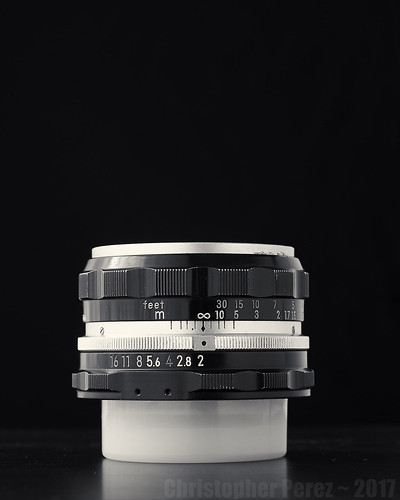
Visiting this year's Photo Foire out in Bievre turned out to be a very dangerous thing to have done. I found this lens for 40Euro.
The lens in question is a Nikon Nikkor 50mm f/2 H pre-Ai. I bought it after the man showed me a nice minty Ai version, but wanted 80Euro for it. When I balked at the price he handed me this one and said 40Euro.
OK. That's fine. Two 20Euro notes lighter and I had this very small very light weight lens in my pocket. Yes. I know. These can be had for just one 20Euro note. Impatience will do that to a guy an make his wallet lighter quicker.
The reason I looked for this kind of Nikkor is that it was first built in the late 1950's and implements the by now very classic Double Gauss six element in 4 groups design. The Double Gauss design itself dates to the latter part of the nineteenth century and was a modification made by Bausch and Lomb to an original Carl Zeiss design from the early part of the nineteenth century.
The design has given rise to some of the finest lenses ever made. Zeiss, Schneider, Nikon, Mamiya, and nearly all photographic lens manufacturers have built something to this specification. Plasmat, Xenotar, Biotar, Dallmeyer Super Six, Xenon, Ultron, Ektar, Super Speed Pancro, and Summicron are just a few of the Double Gauss design trade names sold to photographers over the years. I loved my old Xenotar lensed Rolleiflex TLR's. The image quality is world renowned.
The Nikon Nikkor 50mm f/2 implemented the classic design with minor modifications. The forward three elements are slightly larger than the rear groups. I read somewhere that this was done to compensate for the mirror of the Nikon F series SLRs the lens was made to fit.
Faster versions of the design (ie: f/1.4, f/1.2, f/1.0) are all derivatives of the basic layout. But the faster versions break from the six element four group implementation by splitting various groups into more, separate elements. That's why these faster lenses are more complex and seem to have more trouble controlling the various aspects of scene rendition. Wanting to avoid the increased optical complexities of very fast lenses I sought out the f/2 for it's simpler, basic, classic implementation.
In practice and when used with a Lens Turbo II focal reducer on my Sony APS-C mirrorless cameras the lens is wickedly sharp in the center and contrasty across the field from wide open. It's sharper wide open than the f/1.4 pre-Ai version at f/2. The corners are a soft wide open, but some of this comes from field curvature. In any event the corners clean up fairly well by f/4 or f/5.6 where the field flattens out.
[example1, example2]
The only fly in the ointment is that the highlights are soap-bubble shaped in the out of focus regions. This is commonly referred to as "bad bokeh". If memory serves, a Zeiss whitepaper I read some years back suggested that soap-bubble out of focus highlights are caused by over correcting a lens in the out of focus regions. While I'm not crazy about soap-bubbles, there are lenses that sell for a great many pieces of silver which specialize in soap-bubble effects.
Disaster struck one day when I went to remove a camera from a bag. The camera strap caught this little lens and flung it across the closet. Even though the lens was wrapped in a protective cloth and even though the drop wasn't all that far, and even though the lens cap was the first thing to hit, the front rim of the 50mm f/2 was slightly turned.
I checked the resolution after the fall. There seems to be no change in sharpness nor in overall optical alignment. Still, I feel ill thinking about having dropped this wee-beasty. It's only the second lens I've ever dropped.
The first lens I ever dropped was a Canon 200mm f/3.5 FL which I stupidly let slip off my shoulder during an F1 practice session back in the day when the Circus ran at Long Beach. But that's another story for another time.
No comments:
Post a Comment